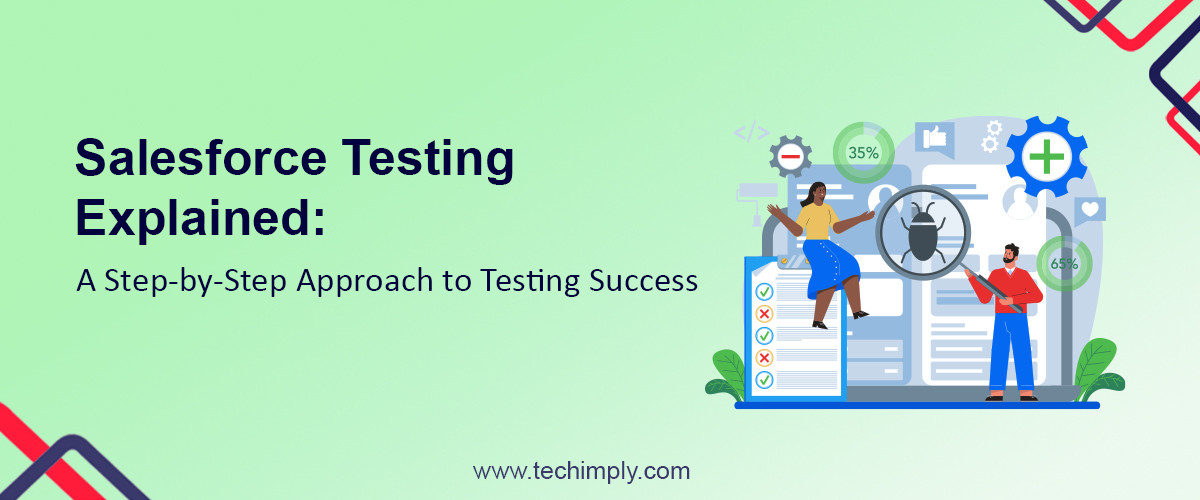Salesforce is a well-known CRM software (customer relationship management) used by companies of all kinds, on a global level, to handle client data and further simplify sales operations. Salesforce, just like any other software tool, must be properly and meticulously tested to guarantee its operation, usability, and dependability. In this article, we'll explore the various steps of Salesforce testing that will aid in guaranteeing testing success.
Step 1: Understand The Requirements
The very first step in Salesforce testing is to analyze and understand the application's basic requirements. It's critical to understand what the system intends to accomplish, how it's supposed to do it, and also what the consumers expect. The requirements might come from a variety of sources, including user experiences, functional specifications, and use cases.
Thus, analyzing the requirements encourages the development of test cases to validate the system.
Step 2: Make A Test Plan
Once the criteria have been determined, the following step is to develop a test strategy. Typically, the test plan determines the prime objectives of testing, the scope of testing, and the technique of testing that needs to be employed. Furthermore, It also defines the various responsibilities of the testing team members, along with the testing schedule and environment. Also you can consider Prepaway for free certification exam questions.
Before testing begins, all the relevant stakeholders should review and approve the test plan.
Step 3: Establish Test Cases
The next stage is to develop distinguishing test cases that will be incorporated to validate the Salesforce application. Generally, these test cases must include all system functional areas and be developed to test both positive and negative scenarios. Positive scenarios analyze the system's efficiency while everything is operating properly.
Negative scenarios, on the other hand, test how the system responds when anything goes wrong. Test cases should also be created to evaluate Salesforce's interaction with other systems, such as external databases or APIs.
Step 4: Setup The Test Environment
The setting in which the Salesforce application is examined is can be understood as the test environment. It is highly critical that the test environment is the exact same as the production environment, with identical hardware and software setups. Moreover, the test environment should be set up with all of the suitable user roles, profiles, and permissions for performing the tests.
Step 5: Running The Test Cases
The next prominent step is to set up the test cases. During the execution of the test, it is vital to continually monitor the outcomes of every test case, along with whether it passed or failed and if there were any errors identified. It is also crucial to document the errors in test cases with an accurate description of the issue, including screenshots and log data. Finally, once the fault is rectified, it is essential to retest the failed test cases.
Step 6: Defect Reporting And Tracking
Salesforce testing heavily relies on defect reporting and monitoring. Defects should be submitted through a defect tracking system, such as JIRA or Bugzilla, with a thorough explanation of the issue and steps to duplicate the problem. Defects should be prioritized depending on their severity and influence on the system and resolved by the relevant team members.
Defect tracking promotes greater communication and collaboration among team members while also ensuring that problems are fixed on time.
Step 7: Regression Analysis
Regression testing is the practice of retesting previously tested functionality to confirm that it continues to perform as intended following system modifications. Regression testing is required after every release or system upgrade to guarantee that no previously working functionality has been compromised. To save time and effort, regression testing should be automated wherever feasible.
Step 8:User Acceptance Testing
The final phase in Salesforce testing is User Acceptability Testing (UAT). End-users do UAT to ensure the system fulfills their business requirements and expectations. To guarantee that the system operates as intended, UAT should be done in a production-like environment using real data. UAT should also be backed by test cases that span a wide range of user situations and business processes.
End users should run the test cases and offer comments on the system's functionality, usability, and general performance during UAT. Before the system is put into production, any errors or discrepancies discovered during UAT should be recorded and corrected.
Step 9: Performance Evaluation
It is critical to do performance testing to guarantee that the Salesforce application can manage the predicted workload and user traffic. It entails putting the system's reaction speed, scalability, and stability to the test under various load situations. This testing aids in the identification of any performance bottlenecks or issues that must be addressed in order to optimize the application's performance.
Step 10: Security testing
Because CRM software handle sensitive client data, security is an important consideration. Security testing aims to detect vulnerabilities and guarantee that the system is safe against unauthorized access, data breaches, and other security threats.
This involves putting authentication procedures to the test, encrypting data, implementing role-based access restrictions, and adhering to industry standards and best practices. To maintain a strong and secure Salesforce environment, security testing should be performed throughout the development lifecycle.
Step 11: Automated Testing And Continuous Testing
Salesforce testing should be incorporated into the development process through continuous testing and automation to ensure continued quality and efficiency. Pipelines for continuous integration and continuous delivery (CI/CD) may be built up to automate test case execution, regression testing, and deployment to multiple environments.
This strategy allows for speedier feedback cycles and early issue discovery, as well as ensuring that new additions or modifications do not generate regressions or disturb current functionality.
Step 12: Knowledge Sharing And Documentation
It is crucial to document test artifacts such as test cases, test plans, and defect reports throughout the testing process. This documentation will be useful for future testing cycles and will give significant insights to the development team.
Furthermore, knowledge exchange sessions and regular contact between team members promote a collaborative testing atmosphere. Sharing best practices, lessons learned, and test automation strategies all add to Salesforce testing's overall effectiveness.
To Wrap Up
Salesforce testing is critical to ensure the CRM platform's performance, dependability, and security. Organizations can achieve optimal testing success by following a step-by-step method that includes understanding the requirements, building various test cases, executing tests, tracking the defects, and further performing various forms of testing.
Adopting continuous testing and automation practices improves the efficiency and quality of the testing process even more. Businesses can give their users a seamless and more reliable CRM experience by investing in extensive and well-executed nCino Salesforce testing, resulting in greater customer happiness as well as productivity.






